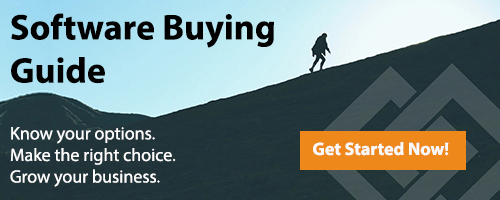As a new business, one important consideration to make is what (if any) business management software is required. For most small wholesale and distribution businesses, this usually means acquiring software for managing accounting procedures and then using manual processes or Excel for tracking inventory and other business processes. However, as your company grows and evolves over time, there will come a point where making a strategic investment in more robust inventory management accounting software is important to continue to be successful. Once you have made the decision to start looking for new software, take the time to evaluate your existing processes and future plans, and educate yourself on the software options available to you in the market. Speaking with multiple vendors and spending the time having detailed discussions and viewing demos can become overwhelming if not properly prepared. As part of your search process, consider the following before engaging with potential software vendors.
1. What is the reason you're searching for software?
Are you searching for new software as a strategic investment and because you believe in the productive power of technology and applications? Or are you searching for software because you feel it is time to make a change? As you begin to plan for company growth and expansion, consider the implications software can have on helping you achieve your business goals and meet your growth projections. The inclusion of more advanced software within your business plan can help make sure you have ample time to find and implement the right solution, before your processes become unmanageable with your existing system. In order to best prepare for implementing advanced inventory management accounting software, it is important that you understand the limitations of your existing software. Knowing when to transition systems will depend on several factors, such as:
- An increase in transaction and order volume. Does your existing system have limitations on the amount of transactions it can handle and size of its database?
- Need for additional features. As your business grows, it is likely that you will require additional features to accommodate selling through new sales channels, opening multiple locations and expanding to new geographic markets.
- Opportunities for automation across departments. Manually managing specific tasks can start to hinder company growth as you experience an increase in order and transaction volume, and can result in time spent fixing errors associated with using multiple, standalone systems.
2. Is your company ready to accept new software?
When implementing any major change within your company, it is expected that there will be some resistance by staff. This can often be one of the biggest barriers to overcome and is a natural reaction for those used to certain processes, however, it is also something that can be easily addressed by management with the right preparation.
First and foremost, be prepared for this resistance and start by educating employees on the differences between introductory type systems and more advanced inventory management accounting software. Explain how making the switch will benefit the company as a whole. One of the biggest reasons why employees are resistant to change when it comes to software is because they are afraid they will lose their jobs. Another reason is because they are also worried that they will not be able to do their jobs with a new system. Although implementing more advanced software can save you from having to hire more employees down the road, typically it does not replace existing employees. Instead the idea is that the right system will replace the more mundane and administrative tasks those employees are responsible for, and provide new features previously unavailable.
Getting your employees on-board for new software and internal changes requires:
- Clearly illustrating the need for change and how it can have a positive impact on the company as a whole
- Involving employees throughout the process of selecting a system and changing procedures
- Making incremental changes and setting realistic expectations – let employees know that there will be a learning curve involved in getting used to new software, and that the company is prepared to help manage this
- Provide as many resources as possible to support the change, including proper training material, a channel where employees can voice concerns and on-going support resources
3. Is the system right for your business?
When you start to evaluate software you want to make sure you find a solution that is right for your business. This means being open to hearing from a variety of vendors and approaching the search with a thorough understanding of your existing processes, and requirements moving forward. Although cost is an important consideration when evaluating vendors, focus first on specific functionality and industry experience, as well as cultural fit. Does the vendor have experience with companies in the same industry? Do they have additional functionality that can be added on as your business continues to grow? Although you might not need all the bells and whistles upfront, understanding the direction you want to take your business in the next couple of years will give you a better idea of specific functionality you may require down the road. It is also important to evaluate vendors based on their company size, on-going after sale support and customer satisfaction. You want to work with a vendor that can become a trusted business partner, offering expert advice to help your business save costs, increase efficiencies and take advantage of new opportunities.
Download our eBook: 6 Factors for Evaluating Software Vendors
4. What is the Total Cost of Ownership (TCO)?
Another important factor to consider when evaluating different inventory management accounting systems is the total cost of ownership over a span of several years. This often comes into play when deciding whether or not to implement a cloud-based solution or on-premises based solution. Although there is no easy answer as to which deployment method is best for your business, there are certain instances when one may be more appropriate over the other. Aside from some of the pros and cons of infrastructure management, it is also important to evaluate long-term differences in costs. When speaking with vendors, get them to help you prepare 1 year, 3 year and 5 year TCO analysis of each deployment method to better determine which one is the best economical choice for your business. Specific factors to include in a cost comparison are:
- On-going monthly fees
- Maintenance costs
- Initial server set-up and implementation
- Back-up media and on-going server management
- Server hardware
- Other software licenses
5. How will you measure Return on Investment?
When investigating a possible inventory management accounting software purchase, some companies try to use the return on investment (“ROI”) as a tool to justify the project, select a vendor, and/or measure the project’s success. This is typically seen more so with larger companies as opposed to those in the small-medium enterprise space, as it can be difficult to quantify some of the expected benefits - particularly when the project is part of a strategic plan to aggressively grow the company. There is also a debate to be had over the validity of trying to build an ROI model for software implementations that result in an annual spend of less than 0.5% of revenue.
However, assuming the implementation is at least moderately successful, one simple way to ensure that your company maximizes its ROI on a software investment is to use it properly. Although this seems like an obvious answer, it is surprising how many businesses implement new software and then continue to use old methods and work around the new system. To avoid this issue, make sure you follow up with your vendor of choice a couple of months after go-live on a formal and scheduled basis, to discuss using the entire system properly, and to make sure you’re taking advantage of available functionality.











